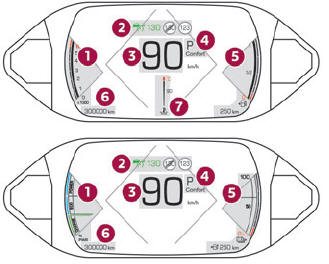DS 3: Temporary puncture repair kit / Checking/adjusting tyre pressures
DS 3 2016-2026 Owners Manual
The compressor can be used, without injecting sealant, to check and, if necessary, adjust the tyre pressures.
- Remove the valve cap from the tyre and keep it in a clean place.
- Uncoil the pipe stowed under the compressor.
- Screw the pipe onto the valve and tighten firmly.
- Check that the compressor switch is in position "O".
- Fully uncoil the electric cable stowed under the compressor.
- Connect the compressor's electric plug to the vehicle's 12 V socket.
- Switch the ignition on.
- Start the compressor by placing the switch at position "I" and adjust the pressure to the value shown on the vehicle's tyre pressure label. To deflate: press the black button located on the compressor pipe, near the valve connection.
 If after 7 minutes the
pressure of 2 bar is
not reached, the tyre is damaged; contact
a dealer or a qualified workshop for
assistance.
If after 7 minutes the
pressure of 2 bar is
not reached, the tyre is damaged; contact
a dealer or a qualified workshop for
assistance.
- Once the correct pressure is reached, put the switch in position "O".
- Remove the kit and stow it.
- Refit the cap on the valve.
 Should the pressure of one
or more tyres
be adjusted, it is necessary to reinitialise
the under-inflation detection system.
For more information on Tyre under-inflation
detection, refer to the corresponding section.
Should the pressure of one
or more tyres
be adjusted, it is necessary to reinitialise
the under-inflation detection system.
For more information on Tyre under-inflation
detection, refer to the corresponding section.
 Repair procedure
Repair procedure
Do not remove any foreign
bodies (e.g.
nail, screw) which have penetrated into
the tyre.
Park the vehicle without obstructing traffic
and apply the parking brake...
 Spare wheel
Spare wheel
Scan the QR Code on page 3
to view
explanatory videos.
For more information on
the Tool kit, refer
to the corresponding section...
Other information:
DS 3 2016-2026 Owners Manual: DAB (Digital Audio Broadcasting) radio
Terrestrial Digital Radio Digital radio provides higher quality sound. The various "multiplexes/ensembles" offer a choice of radio stations organised in alphabetical order. Press Radio Media to display the main page. Press the "OPTIONS" button to access the secondary page. Press "Band" to select "DAB band". Press in the shaded area to confirm. FM-DAB Follow-up "DAB" does not cover 100 % ..
DS 3 2016-2026 Owners Manual: Advice
The driver must ensure that passengers use the seat belts correctly and that they are all fastened before setting off. Wherever seated in the vehicle, you must always fasten the seat belt, even for short journeys. Do not invert the seat belt buckles, as they will not fulfil their role properly. To ensure the proper functioning of the belt buckles, make sure that there are no foreign bodie..
Categories
- Manuals Home
- 1st Generation DS 3 Owners Manual
- 1st Generation DS 3 Service Manual
- Service indicator
- Stop & Start
- AdBlue® range indicators (BlueHDi)
- New on site
- Most important about car
Digital instrument panel
This digital instrument panel can be customised. Depending on the display mode selected, certain information is hidden or presented differently.

Copyright © 2026 www.ds3manuals.com
